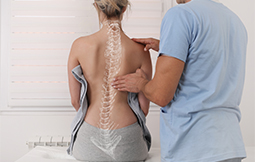
Scoliosis is a curve in the spine that occurs most often during the growth spurt just before puberty. Most of the cases of scoliosis are mild, but some spine deformities continue to get more severe as the child grows.
Scoliosis is a curve in the spine that occurs most often during the growth spurt just before puberty. Most of the cases of scoliosis are mild, but some spine deformities continue to get more severe as the child grows. Severe scoliosis can be disabling. An especially severe spinal curve can reduce the amount of space within the chest, making it difficult for the lungs to breathe or to function properly.
Before you are admitted to the hospital for your surgery, talk to your family about your hospital stay and discuss the help that you’ll need when you will return home. Also once you get back to home your doctor and treatment team will give you instructions to follow at your home. Before your surgery the nurses might do some tests like checking your blood pressure or temperature. Also the hospital staff will let you through all the details that you might need to know about your surgery.
Severe scoliosis typically increases with time, so your doctor can suggest you the scoliosis surgery to reduce the severity and to prevent it from getting worse. Spinal Fusion is the most common type of scoliosis surgery. In this the surgeon connects the two or more than two bones in the spine (vertebrae) together, so they cannot move independently. They place pieces of bone or a bone-like material between the vertebrae. To hold that part of the spine straight they use metal rods, hooks, screws or wires while the old and new bone material fuses together. If the scoliosis is progressing rapidly at a young age, surgeons will suggest you to have a rod installed so that it can adjust in length as the child grows. So usually they attach this growing rod to the spinal curvature at the top and bottom sections, and after every six months this rod lengths bit by bit.
After your surgery your physiotherapist will teach you the breathing exercises and foot and toe exercises. You will also be shown how to turn in a special way called logrolling. You will be log rolled by someone in bed for the first 2 to 3 days or so, until you can turn over by yourself. About 2 to 3 days after the operation the drips may be removed. The physiotherapist will help you to gradually start to stand up and you may need to wear a brace to protect your spine for 3 to 6 months. After 6 to 9 days after surgery the patients are usually able to go home. Staff will make sure that you can manage stairs before going home.
Copyright © 2025 IMA | All Rights Reserved.